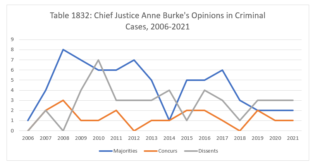
This time, we’re reviewing Chief Justice Anne Burke’s opinions since joining the Court in 2006. One note before we begin – I’ve cut off the tabulations for 2021 at the same date for each of the Justices’ profiles.
In all, the Chief Justice has written 81 majority opinions in civil cases. She has written six special concurrences and 15 dissents. Her heaviest workloads for majority opinions were 2011 and 2013, when she wrote seven majority opinions. The only year in which she has written more than one special concurrence was 2012, with two. She wrote three dissents in 2010 and 2015.

Chief Justice Burke has written seventy majority opinions in criminal cases. She has written twenty special concurrences and forty-four dissents. Her heaviest year for majority opinions was 2008 with eight opinions. Her lightest full year was 2014, when she wrote only one majority. She wrote three special concurrences in 2008. She wrote a high of seven dissents in 2010 (as compared to only six majority opinions that year) and lows of zero in 2008 and one in 2015 and 2018.

Join us back here on Tuesday as we continue our review of the Chief Justice’s tenure.
Image courtesy of Flickr by Joe Vahling (no changes).




























